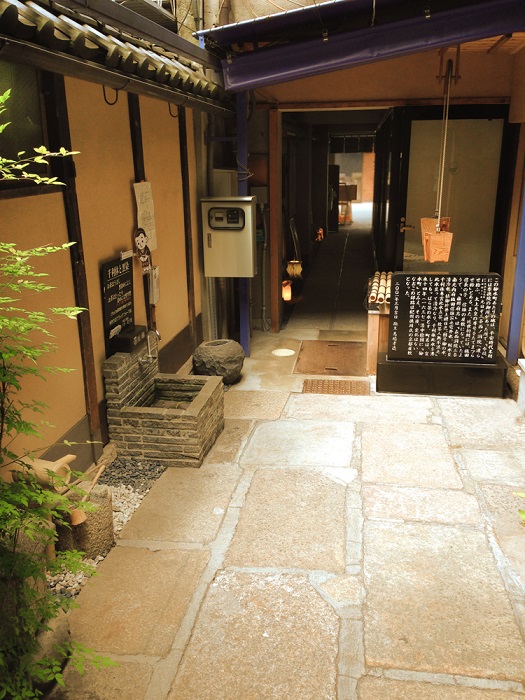experience
Latest content and event information
-
Inside Towaryokan, located near Nishi Honganji Temple, there is a tea room called Seikaan, which was named after the 16th head master of the Urasenke school. We have set up a gentle and fun tea party experience plan for a limited time, because we want everyone to have a gentle time experience in this quiet and tranquil space.
The tea ceremony has an image of being difficult to enter, but even beginners are welcome! Please feel free to join us! We will carefully guide you through the process while listening to explanations about etiquette when entering the tea room, viewing the beds and flowers, etc. Please relax and take photos while seated.
Although it is near Kyoto Station, which is busy, it is quiet and gentle...that's how time passes.
Please feel free to join us for a cultural experience in Kyoto.
*Information will be provided in Japanese.
Management: Towa Ryokan
tea ceremonyTea CeremonyTea ceremony experienceLink KyotoKyoto experienceKyoto StationTea ceremonytea roomLINK KYOTOKyoto sightseeingexperienceKyoto culturetraditional culture
-
For sustainable tourism in Kyoto, we need to change from just visiting famous places.
LINK KYOTO supports
Produced by Nishizawa Stay Co., Ltd.'s travel business [Hood Travel] “1/KYOTO” is a travel product where you can talk with carefully selected Kyoto people.We support this as a model for tourism that will help Kyoto become sustainable.
Link KyotoKyoto experienceLINK KYOTOKyoto sustainable tourismKyoto sightseeingexperienceKyoto culturetraditional culture
-
By renting a bicycle, you can avoid bus and car traffic and crowds.
Not only can you enjoy sightseeing at your own pace without being bound by timetables, but you can also make discoveries not found in guidebooks, making your own Kyoto trip a reality.
[We have two types of bicycles available]
・Electric assist bicycle standard: For customers who are not confident in their leg strength.Easy to move uphill or over long distances.
・City cycle: Comes with an internal 8-speed transmission to support comfortable cycling.
LINK KYOTObicycleKyoto sightseeingsightseeingexperiencecomfortable
-
An original handmade experience typical of Kyoto!
Would you like to make something original, one of a kind in the world, in a homely shop experience?
Located near Kyoto Station and the Kyoto Aquarium, you can experience original Kyoto-style handicrafts such as making bracelets, scented bags, Kyoto prayer beads, and online scented bags.
Since it is made indoors, you can experience it regardless of the weather or climate, so it is enjoyed by everyone from children to the elderly.
We accept everything from small groups to large groups (need to discuss the number of people), and we offer a variety of experiences such as children's parties and experiences for parents and children to make memories of their trip to Kyoto.Link KyotoHandmadebraceletsachetKyoto prayer beadsaccessoriesKyoto StationKyoto AquariumLINK KYOTOexperienceKyoto's Unique Venuesgenuine
-
Enjoy a pottery experience (painting experience, hand-making experience) of Kiyomizu ware, a traditional craft of Kyoto!
This is the Mori Pottery Museum in front of Kiyomizu-dera Temple.
In addition to selling Kiyomizu ware and other ceramics and Japanese accessories, you can also enjoy pottery experiences such as painting and hand-making.From 1 person to 250 people can experience it at once.
traditional craftspotteryKiyomizu wareLINK KYOTOhistoryexperienceKyoto's Unique Venuesgenuinetraditional culture
-
Come and create your own work using the world's thinnest and most beautiful Japanese gold leaf!
Everyone from students on school trips to people from overseas enjoy the gold leaf stamping experience.
There are three experience courses: Simple Course, Standard Course, and High Grade Course.
gold leaflong-established storetraditional craftsLINK KYOTOhistoryexperienceKyoto's Unique Venuesgenuine
-
Enjoy the handmade experience of making your own family crest goods!
The family crest workshop of Baba Dye Kogyo Co., Ltd., a long-established Kyoto company founded 143 years ago.”Hiiragiya Shinshichi”。
In a quaint workshop that retains the atmosphere of an old dyeing factory, you can make goods with your birthday emblem, your favorite Sengoku warlord's crest, or a historical figure's crest on them.
long-established storefamily crestSengoku warlordtraditional craftsLINK KYOTOhistoryexperienceKyoto's Unique Venuesgenuine
-
You can try making your own ``one-of-a-kind flower hairpin''!
Even small pieces of cloth that would otherwise be thrown away are cherished and used with care.
I want to spread the spirit of tsumamizaiku, so I don't just teach techniques, but I focus on the experience of ``finishing a piece of work''.
The thrill of seeing a small piece of cloth that would otherwise have been thrown away become a wonderful accessory, and the joy of playing with colors will soothe your mind and forget the time.
Please take a look at how much you can bring out the personality of the cloth that changes by pinching it, and how it transforms into a chance encounter and a single flower petal.*The experience is for 2 or more people.
*Please make a reservation in advance.LINK KYOTOsustainablehistoryexperienceKyoto's Unique Venuesgenuinetraditional cultureSDGs
-
We offer a variety of experiences such as Japanese clothing, tea ceremony, calligraphy, flower arranging, and incense listening!
You can enjoy a variety of cultural experiences in a spacious store with a Japanese-style atmosphere.
We accept reservations well in advance so that our customers can enjoy the experience at their leisure.
We will also travel to your desired location other than Kyogokoro, so please feel free to contact us.
At Kyoto Handicraft Center, you can enjoy shopping and dining by reservation.LINK KYOTOhistoryKyoto sightseeingexperienceKyoto's Unique Venuesgenuinetraditional culture
-
See, touch, play and discover the charm of kanji in Kyoto!
Japan's first "museum specializing in kanji" opened in 2016 near Yasaka Shrine in Gion, Kyoto.
This is a facility where you can enjoy learning about Japanese kanji culture through hands-on exhibits.
This is an experiential museum where you can not only look at kanji, but also experience many surprises and discoveries through exhibits that you can touch, learn, and enjoy.
ticketChinese charactersLINK KYOTOhistoryKyoto sightseeingexperienceKyoto's Unique Venuesgenuine










6330-784京ごころ-舞妓-お点前.jpg)

 Kyoto
experience
Kyoto
experience Contact us by phone
Contact us by phone Contact by email
Contact by email